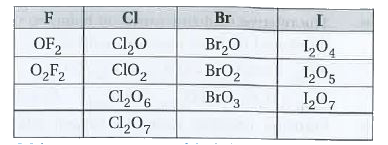Explain reactivity of halogens with oxygen. OR Write a note on oxides of halogens. Solution in Gujrati
Halogens form many oxides with oxygen but most of them are unstable. Fluorine does not forms oxides. The compounds of oxygen with fluorine are called fluorides because fluorine is more electronegative than oxygen. Fluorides of oxygen are OF2 and O2F2. Both are strong fluorinating agents. O2F2 oxidises Pu to PuF6 and the reaction is used in removing plutonium as PuF6 from spent nuclear fuel.
Chlorine oxides, Cl2O,ClO2,Cl2O6 and Cl2O7 are highly reactive oxidising agents. They tend to explode.ClO2 is used as a bleaching agent for paper pulp and textiles and in water treatment. The stability of oxides of chlorine can be explained due to fact that multiple bond formation between oxygen and chlorine takes place due to availability of d-orbitals in chlorine. The bromine oxides, Br2O,BrO2,BrO3 are the least stable halogen oxides (middle row anomanously) and exist only at low temperatures. They are very powerful oxidising agents. The bromine oxides are least stable because :
(i) Bromine cannot form multiple bonds with oxygen.
(ii) Very less polarizability of Br-0 bond.
The iodine oxides, I2O4,I2O5,I2O7 are insoluble solids and decompose on heating. I2O5 is a very good oxidising agent and is used in the estimation of carbon monoxide.
The kinetic and thermodynamic studies show that stability of oxides of halogen follows the order : I > CI > Br. Iodine oxides are highly stable because of greater polarizability of bond between iodine and oxygen. The stability of oxides increases with the increase in number of oxygens in the compound.

Topper's Solved these Questions
- BOOK - KUMAR PRAKASHANCHAPTER - THE P-BLOCK ELEMENTS EXERCISE - SECTION-A QUESTIONS (CHLORINE)2videos
THE P-BLOCK ELEMENTS
- BOOK - KUMAR PRAKASHANCHAPTER - THE P-BLOCK ELEMENTS EXERCISE - SECTION-A QUESTIONS (HYDROGEN CHLORIDE)2videos
THE P-BLOCK ELEMENTS
- BOOK - KUMAR PRAKASHANCHAPTER - THE P-BLOCK ELEMENTS EXERCISE - SECTION-A QUESTIONS (OXOACIDS OF SULPHUR)1videos
THE P-BLOCK ELEMENTS
- BOOK - KUMAR PRAKASHANCHAPTER - THE D-AND F-BLOCK ELMENTSEXERCISE - Section -E MCQs asked in GUJCET/Board Exams)50videos
THE D-AND F-BLOCK ELMENTS
- BOOK - KUMAR PRAKASHANCHAPTER - THE SOLID STATEEXERCISE - SECTION - E (MULTIPLE CHOICE QUESTIONS)(MCQs ASKED IN BOARD EXAMS)35videos
THE SOLID STATE
Similar Questions
Write preparation of dichlorine (Cl2).
04:37View SolutionWrite a note on preparation of hydrogen chloride and state its uses.
View SolutionWrite the names, molecular formula and structural formula of oxoacids of sulphur.
02:37View SolutionWhy 21Sc is not considered as transition element?
02:31View SolutionWhich of the following solids has highest conductivity of heat and electricity ?
03:13View SolutionWrite a short note on the hydrides of halogens.
View SolutionThe order of reactivity of different halogens with alkanes for halogenation is s
01:23View SolutionHalogens are highly reactive ? Explain.
03:01View Solutionकारण सहित समझाइए -
हैलोजेन तीव्र ऑक्सीकारक होते है।04:31View SolutionThe order of reactivity of halogens towards halogenation of alkanes is
05:53View SolutionInter halogens are more reactive than halogens why?
03:53View SolutionWrite an increasing sequence of reactivity of Alkane to various halogens.
02:59View SolutionWrite on the bonding and oxidation states of halogens.
01:29View SolutionWrite a note on : (i)- Electron gain enthalpy of halogens (ii) Electronegativity of halogens.
01:13View SolutionExplain chemical reactivity of halogens.
04:53View Solution

